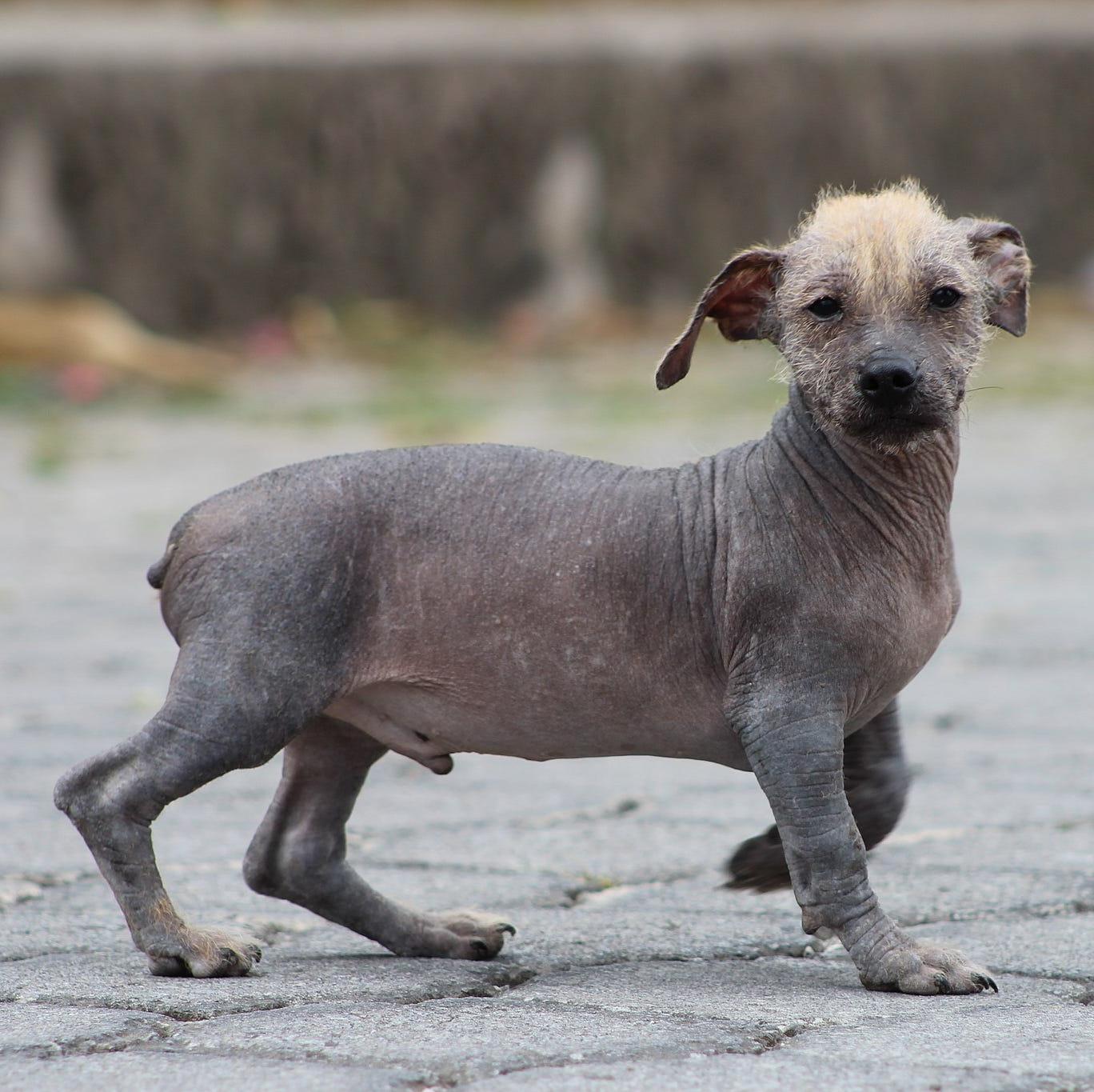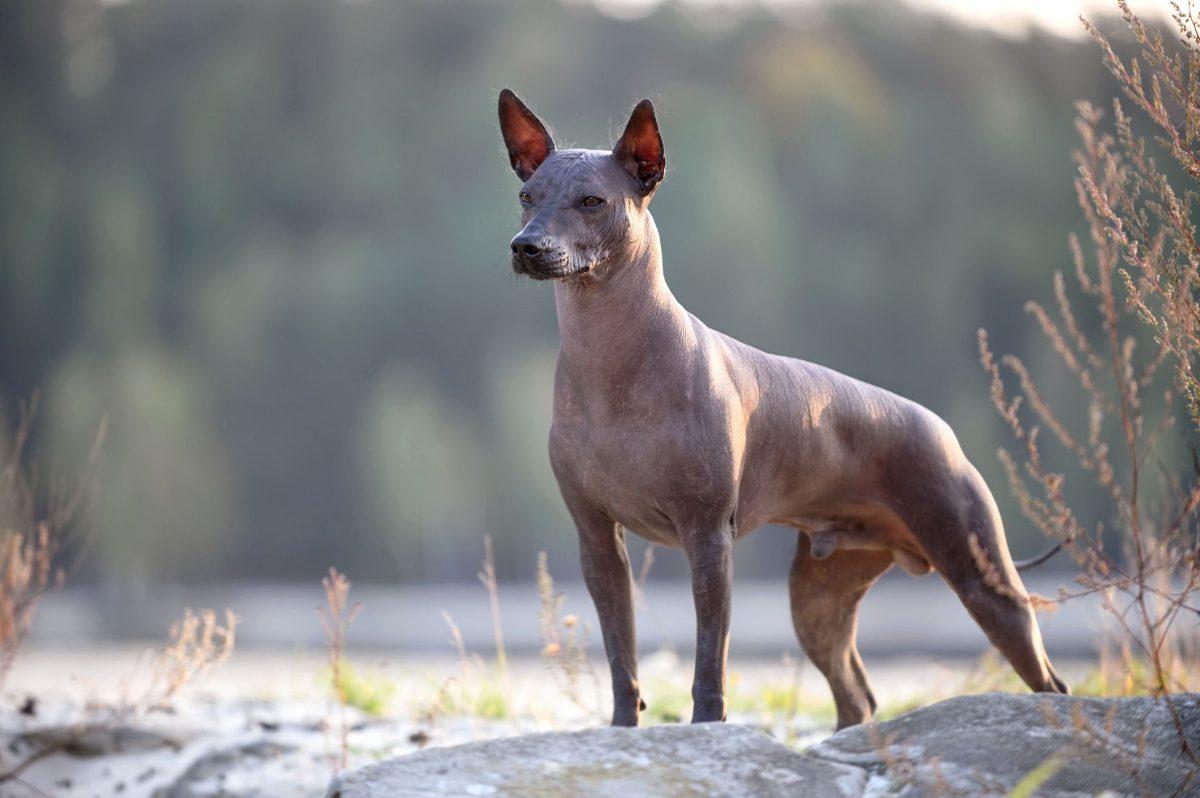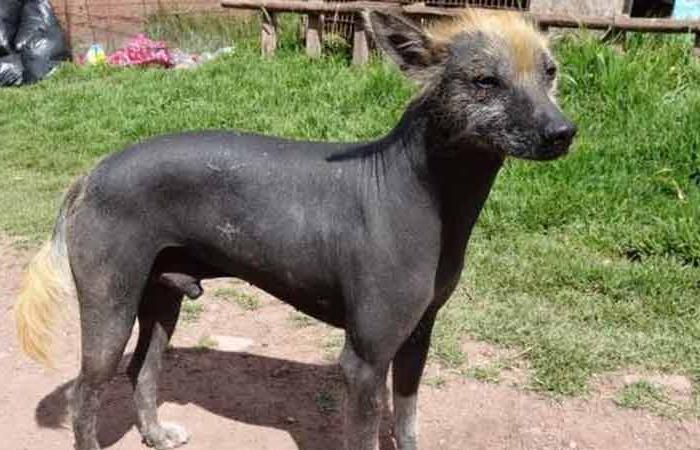- Breed Category: Companion dog
- Country of Origin: Ecuador
- Average Height: 40-50 cm (15.7-19.7 inches)
- Average Weight: 15-25 kg (33-55 pounds)
- Average Life Span: 12-15 years
- Grooming Requirements: Low, occasional baths needed
- Exercise Requirements: Moderate, daily walks recommended
- Coat Type: Hairless
- Coat Color Variations: Dark skin tones
- Shedding Level: None
- Ear Type: Erect
- Tail Type: Curled
- Temperament: Loyal, affectionate, alert
- Intelligence Level: High
- Barking Tendency: Low
- Compatibility with Children: Good with proper socialisation
- Compatibility with Other Pets: Generally good
- Training Ease: Relatively easy with consistency
- Common Health Issues: Skin sensitivity, dental issues
- Dietary Needs: Balanced diet, sensitive to allergies
- Energy Level: Moderate
- Drooling Tendency: Low
- Sensitivity to Weather: High, needs protection from sun
- Overall Maintenance Level: Moderate
- Original Purpose: Companion
- Apartment Friendly: Yes, with sufficient exercise
- Best Suited For: Families, singles, seniors
- Cost of Ownership: Moderate
- Unique Traits: Hairless, ancient breed
- Cultural Significance: Part of Ecuadorian heritage
Imagine a dog that’s not just unique in appearance but also rich in history. Meet the Ecuadorian Hairless Dog, a breed that’s as intriguing as it is rare. This article will take you on a journey through the breed’s characteristics, history, and care needs, offering insights into what makes this dog so special.
The Ecuadorian Hairless Dog, known for its distinct lack of fur, has a history that’s as fascinating as its look. Originating from Ecuador, this breed has been part of the region’s culture for centuries. It’s believed that these dogs were companions to indigenous peoples, valued for their warmth and companionship. Today, they continue to capture the hearts of those who appreciate their unique charm.
Exploring the Ecuadorian Hairless Dog

Early Development of the Breed
The Ecuadorian Hairless Dog has roots that stretch back to ancient times. These dogs were likely bred by indigenous communities, who valued them for their unique traits. Over generations, selective breeding honed their distinctive hairless appearance, which was not just a quirk but a practical adaptation to the warm climate of Ecuador. This early development laid the foundation for a breed that is both resilient and charming.
Cultural Significance in Ecuador
In Ecuador, these dogs are more than just pets; they are a part of the cultural tapestry. Historically, they were seen as symbols of warmth and protection. Their presence in homes was believed to bring good fortune and health. Even today, they hold a special place in Ecuadorian culture, often featured in local folklore and art.
Key Historical Figures and Events
Throughout history, several key figures have championed the Ecuadorian Hairless Dog. Notably, local leaders and breeders have worked tirelessly to preserve the breed’s purity and promote its unique qualities. Events such as national dog shows have helped raise awareness and appreciation for this rare breed, ensuring its survival and recognition on a global stage.
Physical Characteristics
The Ecuadorian Hairless Dog is instantly recognisable by its smooth, hairless skin, which can vary in colour from dark grey to a warm brown. They are medium-sized, with a lean, athletic build that speaks to their agility and strength. Their expressive eyes and alert ears give them an intelligent and curious appearance, making them not just a pet, but a true companion.
Appearance and Unique Traits
The Ecuadorian Hairless Dog stands out with its sleek, hairless skin, which ranges from dark grey to a warm brown. This medium-sized breed boasts a lean, athletic frame, perfect for showcasing its agility and strength. Its skin, free from fur, requires special care to protect against sunburn and dryness, making regular moisturising a must. Despite the lack of a furry coat, these dogs have a striking presence, with expressive eyes and alert ears that convey intelligence and curiosity.
Temperament and Behaviour
Known for their friendly and affectionate nature, Ecuadorian Hairless Dogs are excellent companions. They thrive on human interaction and are known to form strong bonds with their families. These dogs are not just about looks; they have a playful and energetic temperament that makes them great for active households. While they are generally good with children and other pets, early socialisation is key to ensuring they grow into well-rounded adults. Their alertness also makes them excellent watchdogs, always ready to alert their owners to any unusual activity.
Typical Personality Traits
The Ecuadorian Hairless Dog is a bundle of affection and energy. These dogs are known for their loving nature, always eager to be close to their human companions. They are alert and attentive, making them excellent watchdogs. Their playful spirit is infectious, bringing joy to any household.
Suitability as a Family Pet and Companion
These dogs are a fantastic choice for families. Their affectionate nature means they thrive in environments where they can be part of the action. They love being involved in family activities and are happiest when surrounded by their loved ones.
Interaction with Children and Other Animals
Ecuadorian Hairless Dogs generally get along well with children and other pets. Their playful and gentle demeanour makes them great playmates for kids. However, early socialisation is important to ensure they are comfortable and confident in various situations.
Training and Exercise Needs
Training these dogs is usually a rewarding experience due to their intelligence and eagerness to please. Consistent, positive reinforcement works best. They have moderate exercise needs, enjoying daily walks and playtime to keep them physically and mentally stimulated.
Training and Care for the Ecuadorian Hairless Dog
Importance of Early Training and Socialisation
Getting started with training and socialisation early on is crucial for the Ecuadorian Hairless Dog. These dogs are naturally curious and intelligent, so introducing them to different environments, people, and other animals helps them grow into well-adjusted adults. Early exposure to various situations ensures they remain confident and friendly throughout their lives.
Recommended Training Techniques
When it comes to training, positive reinforcement is the way to go. These dogs respond well to treats, praise, and play as rewards. Consistency is key, so regular training sessions will help reinforce good behaviour. Avoid harsh methods, as they can be counterproductive with this sensitive breed.
Daily Exercise Requirements and Activities They Enjoy
The Ecuadorian Hairless Dog has moderate exercise needs. Daily walks and interactive play sessions are perfect for keeping them fit and happy. They enjoy activities that challenge their minds, like puzzle toys or agility courses. Keeping them active not only benefits their physical health but also prevents boredom.
Health and Lifespan
With proper care, these dogs can live a healthy life, often reaching 12 to 15 years. Regular vet check-ups, a balanced diet, and attention to their skin care are essential. Their hairless skin needs protection from the sun and regular moisturising to prevent dryness. By staying on top of their health needs, you can ensure they enjoy a long, happy life.
Common Health Issues
The Ecuadorian Hairless Dog, while generally healthy, can be prone to certain health issues. Their hairless skin is sensitive, making them susceptible to sunburn and skin infections. Regular skin checks and protection from harsh sunlight are crucial. Dental problems can also arise, so maintaining good oral hygiene is important.
Average Lifespan and Health Tips
With the right care, these dogs can live between 12 to 15 years. To keep them healthy, ensure they have a balanced diet rich in nutrients. Regular exercise is essential to maintain their physical and mental well-being. Don’t forget to schedule routine vet visits to catch any potential health issues early.
Preventative Care Recommendations
Preventative care is key for the Ecuadorian Hairless Dog. Regular vaccinations, flea and tick prevention, and dental care are musts. Keep an eye on their skin, using moisturisers to prevent dryness and applying sunscreen when they’re outdoors.
Grooming and Maintenance
Grooming an Ecuadorian Hairless Dog is relatively straightforward. Their skin needs regular cleaning to prevent infections. Bathing them with a gentle, dog-friendly shampoo helps maintain skin health. Moisturising is important to keep their skin supple and hydrated.
Skin Care and Grooming Routines

When it comes to caring for the Ecuadorian Hairless Dog, skin care is a top priority. Their hairless skin is prone to dryness and sunburn, so regular moisturising is essential. Use a gentle, dog-friendly lotion to keep their skin hydrated and supple. Bathing should be done with a mild shampoo to avoid irritation. After a bath, ensure their skin is thoroughly dried to prevent any fungal infections. Regular skin checks are also important to catch any issues early.
Sun Protection and Skincare Tips
Sun protection is crucial for these dogs. Without fur, their skin is directly exposed to the sun’s rays, making sunscreen a must whenever they’re outdoors. Choose a sunscreen specifically formulated for dogs to avoid harmful chemicals. Additionally, providing shaded areas during outdoor activities can help protect their sensitive skin. Remember, prevention is better than cure, so taking these steps can save your dog from discomfort and potential skin damage.
Diet and Nutrition
A balanced diet is vital for the health of the Ecuadorian Hairless Dog. Their diet should be rich in nutrients to support their skin health and overall well-being. High-quality dog food with a good balance of proteins, fats, and carbohydrates is recommended. Omega-3 fatty acids can be particularly beneficial for maintaining healthy skin. Always ensure they have access to fresh water, and consult with a vet to tailor their diet to their specific needs.
Nutritional Needs and Feeding for the Ecuadorian Hairless Dog

Nutritional Needs for Optimal Health
Feeding your Ecuadorian Hairless Dog a balanced diet is crucial for their health. Their unique skin requires nutrients that support skin health, so look for dog food rich in omega-3 fatty acids. These nutrients help maintain skin elasticity and prevent dryness. A diet with a good mix of proteins, fats, and carbohydrates will keep them energetic and healthy.
Foods to Include and Avoid
Include high-quality proteins like chicken or fish, which are great for muscle maintenance. Vegetables and fruits can provide essential vitamins and minerals. Avoid foods high in artificial additives or fillers, as these can lead to allergies or digestive issues. Chocolate, grapes, and onions are toxic to dogs and should be avoided at all costs.
Feeding Schedules and Portion Recommendations
Establishing a regular feeding schedule helps maintain their metabolism. Typically, two meals a day are sufficient for adult dogs. Puppies may require more frequent meals. Portion sizes depend on their age, weight, and activity level, so consult your vet for personalised advice.
Fun Facts and Trivia
Did you know the Ecuadorian Hairless Dog’s lack of fur makes them feel warmer to the touch? This trait was historically valued by indigenous peoples for warmth during cold nights. Despite their hairless appearance, they are not hypoallergenic, as they still produce dander.
Interesting Tidbits about the Breed
The Ecuadorian Hairless Dog is a breed that stands out not just for its appearance but also for its unique characteristics. One interesting fact is that their lack of fur makes them feel warmer to the touch, a trait that was historically appreciated by indigenous communities for warmth during chilly nights. Despite their hairless nature, they are not hypoallergenic, as they still produce dander. These dogs are known for their keen sense of hearing, which makes them excellent watchdogs. Their skin, while sensitive, is surprisingly resilient, adapting well to the warm climates of their native Ecuador.
Cultural References and Significance in Ecuador
In Ecuador, the Hairless Dog is more than just a pet; it’s a cultural icon. Historically, these dogs were seen as symbols of protection and warmth, often believed to bring good fortune to their owners. They frequently appear in local folklore and are celebrated in various forms of art, from paintings to sculptures. Their presence in Ecuadorian culture is a testament to their enduring appeal and significance. Even today, they are cherished as national treasures, embodying the rich heritage and traditions of the region.
Final Thoughts

The Ecuadorian Hairless Dog is a unique and cherished companion. Its rich cultural heritage and distinctive appearance make it a fascinating breed. While caring for this dog requires attention to its skin and dietary needs, the rewards of its loyalty and affection are immense. Embracing the Ecuadorian Hairless Dog means welcoming a piece of Ecuadorian history into your home. Consider adopting this remarkable breed and experience the joy of a truly special companion.
Yes, they are intelligent and eager to please, making them easy to train.
Yes, they are generally good with children and make great family pets.
Yes, they are hypoallergenic due to their lack of fur.
Yes, they are hypoallergenic due to their lack of fur.
Yes, they can get along with other pets if socialized properly.
They may be prone to skin infections and sunburn due to their lack of fur. They may also have dental issues.
No, they do not require much grooming as they do not have fur. However, their skin should be moisturized regularly.
Yes, they can get along with other pets if socialized properly.
They need moderate exercise, such as daily walks and playtime.
They usually grow to be around 40-50 cm tall.
The average weight of an Ecuadorian Hairless Dog is between 8-12 kg.
Their lifespan is typically between 12-14 years.

Lead Editor at JustusDogs, Ayesha is the proud mamma to a Cavalier Charles Spaniel named Sweetipie
